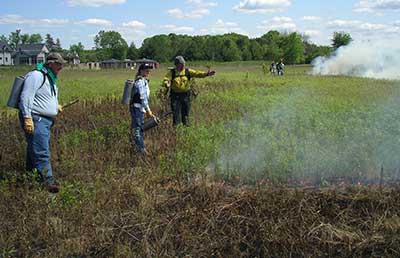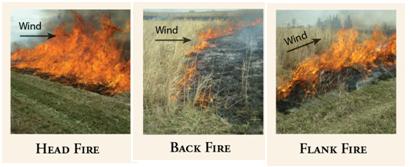
Flank, Head, and Back Fire: Know the Difference?
Every prescribed fire has three types of behavior: flank, head, and back fire. Each is determined by the fire’s position relative to sources of unburned fuel and the wind direction. (Variable wind directions create unpredictable changes in fire behavior, an extremely unsafe situation for life and personal property.)
Below are pictured a flank, head, and back fire. To safely conduct a prescribed burn, it’s critical to know the difference.

Head fire (left) is a line of fire that moves with the wind direction. Because it’s being pushed by the wind, head fire spreads quickly and has long flame lengths (distance from the base of the flame to the tip), making it the most dangerous type of fire.
In a basic prescribed burn, head fire is lit only after backing and flanking fires have been used to secure the edges of the burn unit. Then, when the three types of fires meet in the middle of the unit, the fire burns itself out.
Back fire (center) is a line of fire backing into the wind. Because they’re forced to move into the wind, backing fires have relatively short flame lengths and slow rates of spread. A fire manager will almost always begin a prescribed burn with a backing fire.
Backing fires burn fuels for a longer duration and at higher temperatures at the ground surface than the other two types of fire. Although the flames may not be as large, they are certainly no less effective and in some cases may be more effective in achieving your burn objectives.
Flank fire (right) is a line of fire that parallels the wind direction. The duration, amount of fuel consumed, and temperature achieved are in between those experienced with backing and head fire. This fire is used by the fire manager to move around a burn unit and into the direction of the wind.
